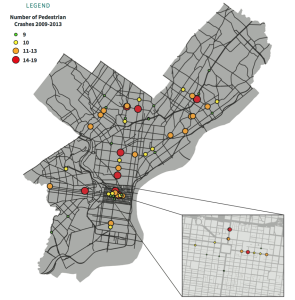Philadelphia has one of the highest rates of pedestrian traffic fatalities in the United States among large cities, according to the National Highway Traffic Safety Administration’s data. The Bicycle Coalition of the Greater Philadelphia has just released the official Vision Zero report, which contains statistics on the safety of Philadelphia streets and a series of policies that aims to bring traffic deaths and injuries down to zero for pedestrians, cyclists and drivers. According to the report, traffic crashes kill about 100 people per year citywide and cost $1 billion in damages and economic activity.
The report breaks down traffic crashes and statistics by neighborhood (see map). In West Philadelphia, the report shows that 52nd Street, between Baltimore Avenue and Sansom Street is the fourth-worst corridor for pedestrian-involved crashes in the city. Also, 40th and Market Streets, where many people are crossing the street to use the Market-Frankford Line, is in the top 10 of crash sites in the city. The intersection saw 15 pedestrian-involved crashes between 2009 and 2013.
Vision Zero policies have already been successfully adopted in other U.S. cities, including New York, Chicago and San Francisco. Vision Zero Philadelphia proposes partnerships among various municipal agencies, and includes recommendations for safer road design, traffic calming strategies, and suggestions for funding sources. The document also stresses the importance of cultural shift and public education campaigns. Both of Philadelphia’s current mayoral candidates support the policies.
The full report can be downloaded here.








June 25th, 2015 at 3:34 pm
Of course 40th/Market is. Pedestrians simply “step-out” into traffic, cross against the light. Many are seniors with disabilities trying simply to get across the street in time; some are students who are looking at cell phones as they exit the El; some are awaiting the 40 bus on their way to rehab in Parkside but first have to make that street-level connection. Suggestion: extend pedestrian time to cross. Philly’s signals are simply too short. Perhaps diagonal pedestrian crossing is also an opportunity with ALL cars stopped
June 25th, 2015 at 5:09 pm
When I’m driving on 52nd, most of my attention is on trying to avoid all the holes and dips. It’s hard to also track the very random pedestrian traffic. Before ‘calming’ the street, maybe it could be repaved and easier to drive. Then study traffic again.
June 26th, 2015 at 3:20 pm
This story gets a huge Pinocchio! So does the bike guy’s piece in the Inky. Low speed limits cause crashes, and this has been know for decades. Radar makes a lot of mistakes and fails the Daubert test. You don’t even know which vehicle made the reading. Speed cameras have made significant errors, even ticketing parked cars.
I think he should learn a bit more before writing an article making himself and his group look quite silly. They should work WITH driving groups, not try to demonize them!
Visit the National Motorists Association for unbiased driving info, unlike this inaccurate piece here.
June 26th, 2015 at 4:24 pm
Are you seriously suggesting that the National Motorists Association sounds totally unbiased, a “membership organization protecting the rights and interests of North American motorists,” is unbiased? Definitely the place to go to the real facts on dangerous driving.
August 5th, 2015 at 11:02 am
So since this came up, a lot of 52nd Street had been repaired and the driving is less fraught. Any info on whether that has affected pedestrian safety?
August 5th, 2015 at 12:18 pm
That’s really funny, LinuxGuy. And hey, after people have visited the National Motorists Association for totally unbiased info about anti-speed measures, they should definitely swing by the National Rifle Association for totally unbiased info about gun control.